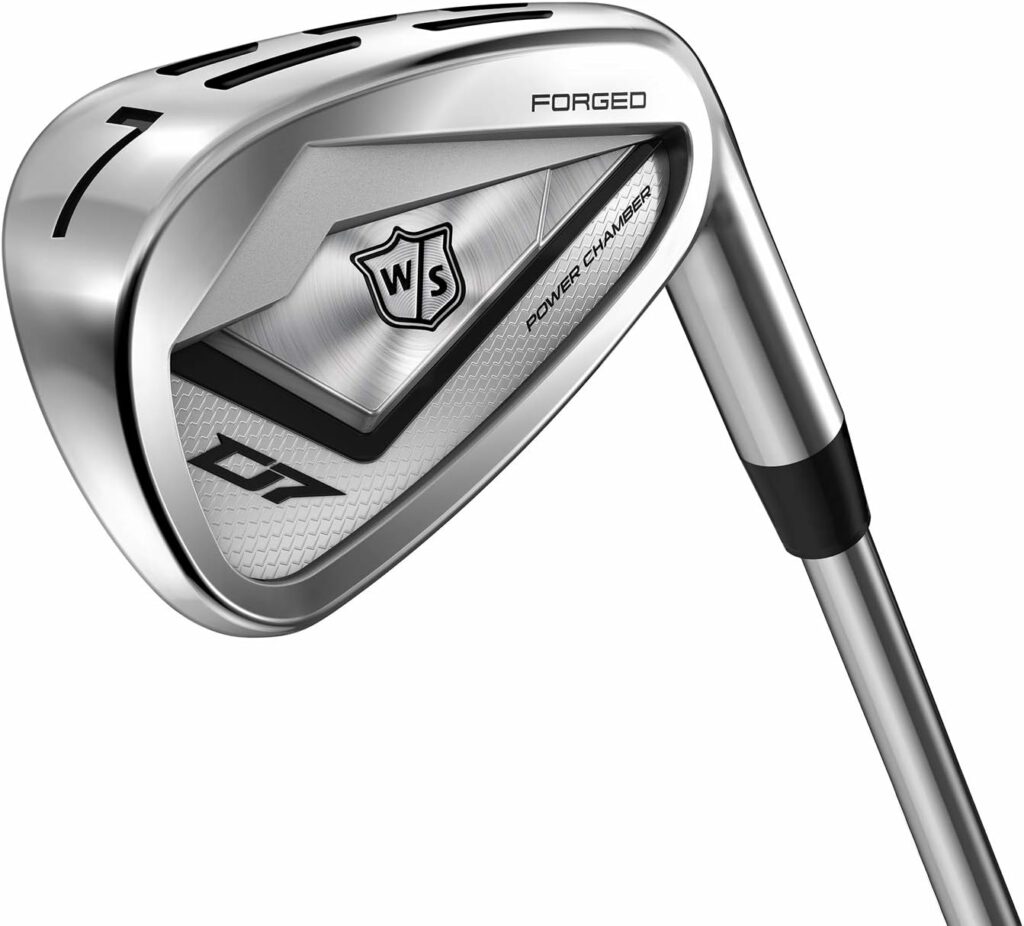The 7 iron is a versatile golf club that can be used for a variety of shots, including off the tees and reaching long par 3s. The 7 iron golf club is classified as a mid-iron golf club and has a loft angle that ranges between 29 degrees to 33 degrees. This golf club is suitable for both beginners and professional golfers.
One of the most commonly asked questions when it comes to the 7 iron is how far it should be hit. According to various sources, the average distance a 7 iron travels is around 120 yards for men and 80 yards for women. However, it is important to note that these are just averages, and individual distances can vary depending on factors such as swing speed, technique, and weather conditions. Knowing how far you hit your 7 iron can be a helpful guide in deciding which tees to play from and which club to use for approach shots.
7 Iron Distance: Just How Far CAN They Hit?

The 7 iron is a versatile golf club that can be used for a variety of shots, including stock shots, full swings, punch outs from under trees, shots over trees and hazards, chipping, and long fairway bunker shots. The 7 iron is classified as a mid-iron golf club and has a loft angle that ranges between 29 degrees to 33 degrees.
The average distance for a 7 iron is approximately 140-150 yards, depending on the golfer’s skill level. However, the distance can vary depending on several factors, such as the golfer’s swing speed, ball flight, and wind conditions. It is important to note that these are just averages, and some golfers may hit their 7 iron further or shorter than the average distance.
To further improve the 7 iron distance, it is important to develop proper technique and understand how different club types affect golf ball flight. For instance, golfers can increase their 7 iron distance by using a club with a longer shaft, a lighter grip, or a lower center of gravity. Additionally, golfers can adjust their swing speed, ball position, and stance to optimize their 7 iron distance.
Overall, the 7 iron is a crucial club in a golfer’s bag, and understanding its distance and versatility can help golfers improve their game.
Understanding Golf Irons
Golf irons are one of the most important clubs in a golfer’s bag. They are designed to hit the ball accurately and with control, making them ideal for approach shots to the green. Irons are numbered from 1 to 9, with the lower numbers representing the longer irons and the higher numbers representing the shorter irons.
Each iron has a different loft angle, which affects the trajectory and distance of the ball. The lower-numbered irons have a lower loft angle and are designed for longer shots, while the higher-numbered irons have a higher loft angle and are designed for shorter shots.
Here is a table that shows the typical loft angles and distances for each iron:
| Iron | Loft Angle (Degrees) | Distance (Yards) |
|---|---|---|
| 1 | 16-20 | 180-210 |
| 2 | 21-25 | 170-200 |
| 3 | 26-30 | 160-190 |
| 4 | 31-35 | 150-180 |
| 5 | 36-40 | 140-170 |
| 6 | 41-45 | 130-160 |
| 7 | 46-50 | 120-150 |
| 8 | 51-55 | 110-140 |
| 9 | 56-60 | 100-130 |
It’s important to note that these distances are just averages and can vary depending on factors such as swing speed, ball type, and course conditions.
Golfers should also be aware of the different types of shots that can be made with irons. Some common types of shots include:
- Full swing: This is a standard shot where the golfer takes a full swing with the club to hit the ball as far as possible.
- Punch shot: This is a low-trajectory shot that is useful for getting out of trouble or hitting under tree branches.
- Bump and run: This is a low-trajectory shot that is useful for getting the ball to roll along the ground and onto the green.
- Lob shot: This is a high-trajectory shot that is useful for getting the ball to stop quickly on the green.
Overall, understanding golf irons is crucial for any golfer who wants to improve their game. By knowing the loft angles, distances, and different types of shots, golfers can make more informed decisions on the course and improve their chances of hitting accurate shots.
Golf Techniques for Maximizing 7 Iron Distance

When it comes to maximizing 7 iron distance, there are a few techniques that golfers can use to hit the ball further and more accurately. Here are some tips to help golfers improve their 7 iron distance:
1. Use Proper Grip and Stance
A proper grip and stance are essential for maximizing 7 iron distance. Golfers should grip the club with their fingers and not their palms, and their hands should be positioned slightly to the right of the clubface. The stance should be shoulder-width apart, with the ball positioned in the center of the stance.
2. Maintain a Steady Head
Maintaining a steady head during the swing is crucial for maximizing 7 iron distance. Golfers should keep their head still and focus on the ball throughout the swing. This will help them maintain their balance and generate more power.
3. Use the Correct Loft Angle
The loft angle of the 7 iron plays a significant role in determining the distance the ball will travel. A higher loft angle creates more backspin, which helps the ball stay in the air longer and travel a greater distance. Golfers should experiment with different loft angles to find the one that works best for them.
4. Practice, Practice, Practice
Like any other aspect of golf, improving 7 iron distance requires practice. Golfers should spend time on the driving range, hitting 7 iron shots and experimenting with different techniques. With practice, they can develop the muscle memory needed to hit the ball further and more accurately.
5. Experiment with Ball Position and Posture
Experimenting with ball position and posture can also help golfers get more yards out of each 7 iron shot. Golfers should try moving the ball forward or backward in their stance to see how it affects their shot. They should also experiment with different postures, such as bending their knees more or less, to find the one that works best for them.
By using these techniques, golfers can improve their 7 iron distance and take their game to the next level.
Choosing the Right 7 Iron for Your Game
Choosing the right 7 iron is essential for golfers of all skill levels. There are several factors to consider when selecting a 7 iron that fits your game. Here are some tips to help you choose the right 7 iron for your golf bag:
Anyway, as luck would have it – I’ve done some digging to find you some of the best 7 irons available on Amazon. Let’s dive in! 🏌️♂️⛳
1. Callaway Golf Rogue ST MAX Iron
This one is a best-seller on Amazon and has a 4.7-star rating. It’s currently priced at around $114.28, down from $142.86. A great deal if you ask me! Callaway is a trusted brand in the golf world, so you can’t go wrong here.
2. LAZRUS Premium Golf Irons
This set includes a 7 iron and is listed as the #1 Best Seller in Golf Iron Sets on Amazon. The set is priced at around $294.03. LAZRUS is known for quality and affordability.
3. BombTech Golf 4.0 Iron Set
This set also includes a 7 iron and is priced at around $275.00. It’s listed as the #2 Best Seller in Golf Iron Sets on Amazon. BombTech is another brand that’s been getting a lot of love from golfers.
4. Square Strike Irons
This set includes 7, 8, 9 irons and is available for both men and women. You can find it on Amazon. Square Strike is a brand that focuses on making golf easier and more enjoyable.
5. Men’s Powerbilt Golf EX-550 Hybrid Iron Set
This set includes a 7 iron and is priced at around $279.95. It’s available on Amazon and is a good option if you’re looking for a hybrid set. Powerbilt is a brand that has been around for a while and is known for its quality.
Conclusion
In conclusion, the average distance a golfer can hit a 7 iron depends on various factors such as swing speed, loft, and club type. According to The Brassie, a golfer with an average swing speed and club loft can hit the 7 iron about 140 yards, while a senior or slower swing speed player could hit it closer to 130 yards. However, professional golfers like Dustin Johnson and Rory McIlroy can hit a 7 iron over 200 yards.
Ultimately, the distance a golfer can hit a 7 iron will vary based on their individual swing and other factors. However, with practice and proper technique, a golfer can maximize the distance and versatility of their 7 iron to improve their game on the course.
Frequently Asked Questions
What is the average distance of a 7 iron shot for a beginner golfer?
The average distance a beginner golfer can hit a 7 iron is around 100 to 120 yards. However, this can vary depending on the individual’s strength, swing speed, and technique.
How does shaft flex affect the distance of a 7 iron shot?
Shaft flex can affect the distance of a 7 iron shot by influencing the trajectory and spin rate of the ball. A stiffer shaft may produce a lower ball flight with less spin, resulting in more distance. On the other hand, a more flexible shaft may produce a higher ball flight with more spin, resulting in less distance.
What is the difference in distance between a 7 iron and an 8 iron?
The difference in distance between a 7 iron and an 8 iron is typically around 10 to 15 yards. This can vary depending on the individual’s swing speed, technique, and the specific clubs being used.
What is the world record for the longest 7 iron shot?
There is no official world record for the longest 7 iron shot. However, various unofficial records exist, with some golfers claiming to have hit a 7 iron over 300 yards.
What is the average distance a man should hit a 7 iron?
The average distance a man can hit a 7 iron is around 140 to 160 yards. However, this can vary depending on the individual’s strength, swing speed, and technique.
How far does the average golfer hit a 9 iron?
The average distance an amateur golfer can hit a 9 iron is around 90 to 110 yards. However, this can vary depending on the individual’s strength, swing speed, and technique. Professional golfers can hit a 9 iron up to 140 yards or more.

